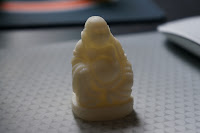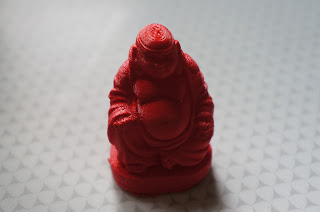In the end I couldn't reliably print PLA with the original E3D V4 Hotend, Sanjay from E3D was nice enough to send me a complete replacement, plus some extras.
I spent 3 or 4 days printing PLA with the new hotend, and while I can get good results from it, I don't think it's an ideal solution for printing PLA.
First I want to sow you how good a print the hot end can produce, this print is in Ultimachine Natural ABS 0.2mm layer height, the model is scaled by 50 %.
I doesn't photograph particularly well, but looks really good, it's hard to find something to criticize about the print. Perhaps the best way to describe prints from the E3D Hotend is "sharp", it does a great job of with detail, as good or better than any Hotend I've used.
The following is the small army of buddhas that are my attempts to get a really good PLA print out of the Hotend.
This army does not include the many complete failures I had early on, any attempt with too aggressive a retraction setting (anything over 2mm on my boden setup) resulted in a print failure with the Hotend jamming. Any attempt to print under ~225C resulted in a jam and failure.
The really observant of you will have noticed that although most of the prints are actually very good they all have issues when printing the head. The forwards most print is perhaps the best of them, so lets take a closer look.
It's somewhat hard to see, but if you look closely what happened in the print, is that at the start of a layer the flow of plastic did not immediately resume. Very shortly afterwards when it did resume, the pressure that had built up during the "stall" caused excess plastic to be extruded part way into the layer, producing the distinct ring on the forehead.
What you can't see without watching the print is why this happens, there are two very distinct places when printing the model where the cooling settings cause the print head to greatly slow down, one is at the top of the coat and one at the point you can see the issue. Some of the models have similar issues at the first point.
What I believe happens is that the retracted filament sticks to the inside of the stainless thermal break when it's primed, and the low extrusion rate isn't enough to overcome this additional force. The pressure slowly builds during the layer and when extrusion resumes you get all the excess plastic deposited very quickly.
My reason for believing this is that you can see it happen when the hotend is blocked, it simply will not extrude, the stepper will stall trying to drive more filament in, you wait perhaps 30s or retract 30mm of filament, and suddenly you see a lot of very liquid filament spew out and the Jam is cleared.
You appear to be able to reduce this effect by increasing the temperature of the print, but I don't have enough cooling to print PLA at much more than 235C (where this print was done) without it introducing other issues.
Now this particular model is particularly challenging at this scale, and I have printed several other PLA pieces that look very good, but there are plenty of none all metal Hotends that will also print this model without the issue.
My conclusion is if you don't print a lot of PLA then this Hotend is really very good, and well worth the investment, the fact that E3D have been responsive in dealing with problems is a big plus as well.
If you primarily print PLA I'd wouldn't by any all metal Hotend right now with the intent of using it as your primary Hotend.
I'm beginning to think that there is no perfect single hotend and the right approach is to have at least 2 and make it fast and painless to swap between them, which I suppose gets back to my 3D printer automatic tool changer idea...
Thursday, June 20, 2013
Sunday, June 2, 2013
A better filament drive?
Ever since I saw Sublime's Tantillus 3D printer using spectra fishing line, I've ben really intrigued by the idea, in fact I built 2 Hbot prototypes using the idea.
The fundamental issue that comes up is that the fishing line "walks" as it wraps around the pulley, this changes the angle of the line, which in turn affects the tension. The problem is worse on a HBot because of the single long belt the number of times that the belt wraps around the pulley to go extent to extent can be large. In fact on my first prototype where I didn't try and address this there is a noticeable change in tension.
There are basically two way to approach the drive Tantillus passes the line through the "pulley" and wraps the filament on and off, this makes it impossible for the line to slip, but it's also difficult to address the walking filament, on Tantillus the combination of short axis and linear line path make this a minor issue that doesn't seem to impact the print quality.
The other option is to have sufficient friction on the drive pulley to prevent slipping, this requires a significant contact area between the line and the pulley and significant tension on the line.
The idea of the figure 8 line drive above is to use an idler to continually reset the filament position, basically the drive pulley in this case has 4 grooves, and the idler 3 that are offset by 1/2 the groove spacing. The filament always rolls onto the top groove on the drive pulley and off the bottom one.
There is no filament walking, and the equivalent of multiple wraps around the drive pulley to provide additional friction.
You can see the prototype running here
As a point of reference I'm running it off the LPC1768 based electronics discussed in other posts.
The idler has 2 9mm bearings in it's center.
I stole the idea for this from somewhere, I think the first time I ever saw it suggested was on the CNC Zone forums regarding wire drives for routers.
I'm pretty happy with the friction from the 3 figure8's, I might reduce the groove spacing on the drive and idler from 1.5mm to 1mm, but 1.5mm seems to work well.
My intent is to use this mechanism on my 4th HBot prototype, though I intend to use the CoreXY mechanics rather than the HBot mechanics, I have most of the X/Y Gantry laid out in CAD, hopefully I can get the CAD work complete this week.
Subscribe to:
Comments (Atom)










